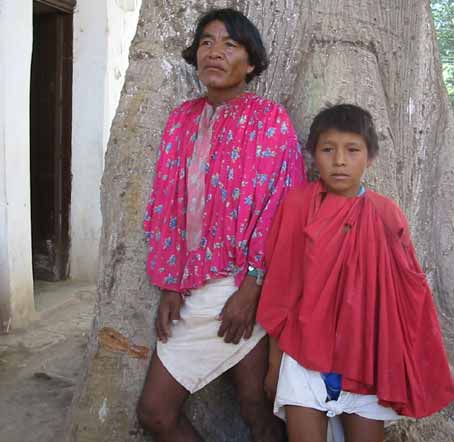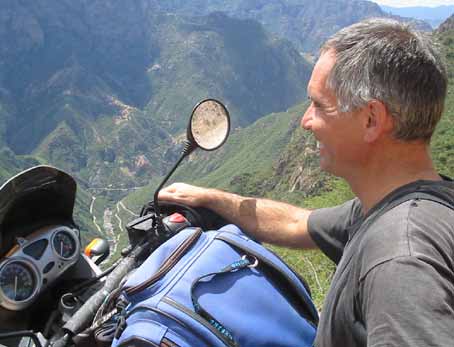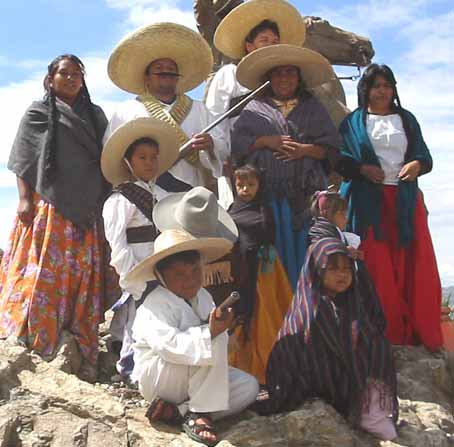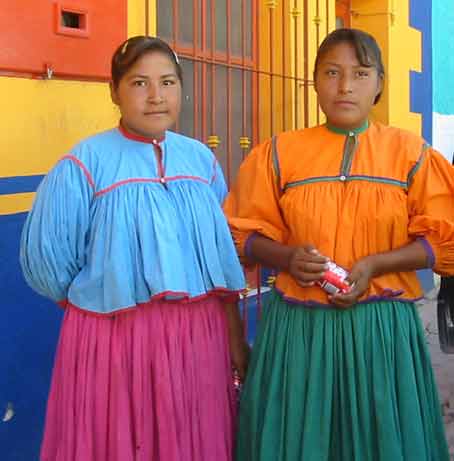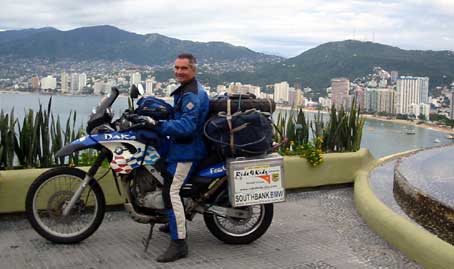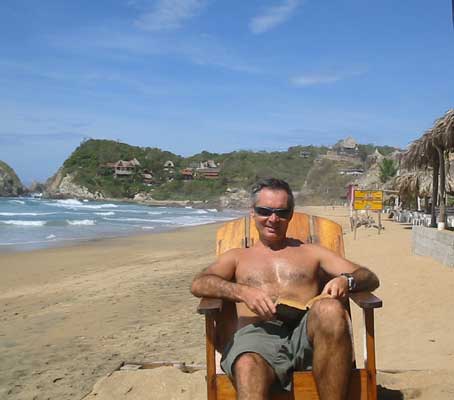Ces
derniers sont l'un des derniers peuples légendaires d'Amérique
à refuser le progrès et à fuir les contacts avec la civilisation
"occidentale". Le rite tarahumara le plus étonnant est une
course à pied qui dure au minimum 24 h, parfois 3 jours consécutifs,
et durant laquelle les coureurs poussent du pied une boule de bois. Ils l'organisent
sur des distances allant jusqu'à 300 Km pour les hommes et 100 Km pour
les femmes. Ils habitent dans des grottes naturelles, mais aussi dans des cabanes
en bois et en pierre. Ils vivent de la culture et élèvent un peu
de bétail, se nourrissant pour l'essentiel de tortillas de maïs,
de pomme de terre et d'haricots.
Un soir j'ai rencontré un couple Américains venu de Washington
qui voyageaient aussi en motos. Judith et Jip Whitefield (tout les deux des
ingénieurs) étaient descendus jusqu'à la frontière
Mexicaine en voiture avec leurs motos derrière dans une remorque. Ils
avaient ensuite continué à
travers le nord du Mexique en moto pour leurs
trois semaines de vacance. J'avais décidé de faire route avec
eux jusqu'à batopilas, un vieux village minier de chercheurs d'argent
fondée au 17ième siècle, au bord d'une rivière.
Ce village se trouve à 140 Km de Créel et se situe en plein
cœur des canyons.
Nous sommes partis le lendemain vers 10 heures; J'avais laissé toutes
mes affaires à la pension sachant que la route allait être très
dur. Les 70 premiers Km étaient sur une route goudronnée mais
les 70 suivants sur un chemin de terre. La route était de toute beauté.
Nous sommes passés de ravin en canyon, en passant des paysages semi
désertiques, d'immenses forêts de pins, avant d'entamer l'impressionnante
descente dans le canyon de Batopilas. Cela nous a pris 6 heures de
route, en passant d'un climat montagnard à un climat tropical, d'une
altitude de 2338 m à 495 mètres. Nous étions tous épuisés
surtout Judith qui n'avait pas l'habitude de conduire sur des routes aussi
difficiles. Nous avons passés la journée suivante à nous
reposer et à nous promener, à pied cette fois, dans les environs.
Le retour fut aussi difficile, il avait plu dans la nuit et la route était
boueuse, Judith tomba plusieurs fois sans se faire mal.
Le lendemain il pleuvait, j'en profitais pour me reposer, quand à mes
amis Américains, ils reprenaient la route en direction de Washington,
les vacances étaient presque finis pour eux.
Mardi 23 Septembre.
Je n'avais pas bien dormi cette nuit là et lorsque j'en parlais à
une famille française avec qui j'avais passé la journée
précédente. Ils avaient eu tous le même problème
et on mettait ça sur le compte du repas de la veille qui avait consisté
principalement de Frijoles 'genre d'haricot plus connu sous le nom de péteu
ou musicien'. Alors pas étonnant que l'on se sentait tous plus ou moins
gazeux. Par bonheur je n'avais pas eu à partager ma chambre. J'en profite
pour passer un petit bonjour à cette famille des Sables d'Olonnes et
je leur souhaite un bon séjour au Mexique.
Bien que le ciel soit toujours menaçant, la pluie avait cessé
et je quittais Créel vers 9 heures sur une chaussée encore mouillée.
La route montagneuse, toujours très sinueuse mais avec des vues extraordinaires,
m'amenait à la ville d'Hidalgo de Parral où je passais
la nuit.
Le lendemain je me réveillais avec un mal de gorge et un nez coulant,
bref, un rhume. Pas question de me laisser aller car je voulais à tout
prix gagner la ville de Zacatecas ce soir même à 700 Km plus
au sud. Heureusement la montagne était finie ce qui me permettait d'augmenter
ma moyenne de vitesse et le soleil aussi était du voyage. J'arrivais
vers 17 heures et je trouvais un hôtel plus ou moins bon marché,
par contre pas de place pour garer la moto. Pas question de la laisser dans
la rue et je trouvait un parking privée ou pour un Euro par nuit je
pouvais laisser ma moto en toute sécurité.
Isolé dans une région semi désertique, Zacatecas
est une ville particulièrement surprenante et fascinante de 100,000
habitants. C'est une ville avec de très anciennes colonial architectures,
dont sa superbe cathédrale, le tout construit par les riches propriétaires
de mine d'argent de la région.
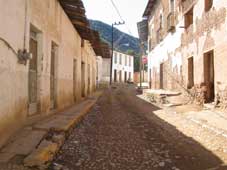
Elle est casée le long d'étroites,
sinueuses rues (photo) au pied de collines spectaculairement rocailleuses. J'ai
passé un bon moment à l'explorer et je n'hésite pas à
la recommander aux personnes visitant le Mexique.
Deux jours plus tard il était temps de reprendre la route mais j'étais
réveillé par une pluie battante et comme je souffrais toujours
de mon rhume je me retournais et me r'endormais en rêvant de jours plus
ensoleillés. C'est ça le plaisir de voyager seul, on fait vraiment
ce que l'on veut et quand on veut. Vers
10
heures la pluie avait cessé mais il était trop tard pour prendre
la route et j'en profitais pour faire une tournée de lessive (le blanc
à part, bien sur).
Le lendemain, rebelote, mais cette fois pas question de jouer les paresseux
et je reprenais finalement la route. Eventuellement, la pluie s'arrêta
vers 11 heures. Comme je voulais à tout prix éviter la ville de
Mexico (je l'avais déjà visité), je prenais la direction
de la côte pacifique où je savais que je retrouverai un climat
plus tropical. Je contournais la grande ville de Guadalajara (deuxième
du Mexique) vers midi mais je continuais car je voulais passer la nuit dans
un petit village de bord de mer connu pour sa tranquillité et son calme.
Après avoir casser une croûte vite fait dans un petit boui-boui
de bord de route j'observais des nuages plutôt menaçant à
l'horizon. Rien ne m'aurais préparé à ce qui m'attendait,
en un instant une éponge n'aurait pu être plus mouillé.
Pas question de m'arrêter car tremper comme j'étais je n'aurais
jamais pu remonter sur la moto, en plus j'avais froid. Avec encore 120 Km devant
moi je combattais les forces de la nature. La visibilité était
nulle et je roulais à pas plus de 20km/h car comme je passais une chaîne
de montagne la route était très sinueuse. Les conditions étaient
tellement difficiles que je me retrouvais tout seul sur la route, même
les voitures avaient fait halte. Le plus j'avançais le plus critique
devenait la situation car le tonnerre avait fait son apparition. Même
avec le bruit de la pluie battante sur mon casque, le déchirement craquant
du tonnerre me faisait faire des bonds, ces explosions assourdissantes me paraissaient
à porter de main. Jamais dans ma vie je me suis retrouvé dans
de telles conditions mais je savais que grâce à mes pneus j'étais
en sécurité, ils me protégeraient de la foudre. Deux heures
plus tard la situation s'améliorait un peu. La pluie, quoique toujours
présente, faiblissait un peu alors que je commençais ma descente
vers la côte. La température remontait lentement et quand j'arrivais
à Colima, une ville a 60 Km de ma destination, le soleil réapparaissait.
L'humidité et la chaleur étaient telle que Je me serai cru dans
un sauna. La route transpirait de condensation et je pouvais voir la vapeur
sortir des terres verdoyantes.
J'arrivais enfin à Cuyutlán vers 17 heures et je m'arrêtais
dans le premier hôtel que je voyais car il indiquait des chambres à
50 pesos (5 Euros), un prix imbattable jusqu'alors pour moi au Mexique. Je n'inspectais
même pas la chambre car à ce prix je savais que je n'aurais probablement
qu'un lit et rien d'autre, peut être une fenêtre si la chance était
de mon côté. Pas de surprise, je payais même pour deux nuits,
pensant que ce serait le temps nécessaire pour sécher tout mon
équipement. Plus tard je visitais le village et découvrais que
pour être tranquille j'allais être tranquille, un peu trop tranquille
à mon goût car le village était désert. Pas un chat
mais des milliers de moustiques. La plage était effectivement très
belle mais je n'avais pas tellement envie d'y passer une journée complète.
Je décidais de reprendre la route le lendemain et quand je demandais
d'être rembourser pour ma deuxième nuit ils me disaient que se
n'était malheureusement pas possible car la réservation avait
été inscrite sur le livre de la maison, une chose prise, nul doute,
très sérieusement dans ce coin perdu. On ne peut pas toujours
faire des affaires. Tant pis, Acapulco (690 Km plus au sud) était ma
destination prochaine et rien n'allait m'empêcher d'y aboutir ce jour
là. La route suivait la côte et je me régalais
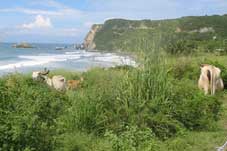
avec
des vues superbes (photo). Palmiers, cocotiers et bananiers me regardaient surfer
la route tandis que l'océan Pacifique me surveillait du coin de l'œil.
Le ciel était d'un bleu parfait avec un beau soleil en plein milieu.
Une journée idéale ou rien ne pouvait assombrir mon humeur.
Je trouvais un hôtel où le propriétaire m'aidait à
entrer ma moto à l'intérieur en montant quelques marches, pas
facile mais préférable. Acapulco est installé sur
la côte de Bahai de
Acapulco
sur une longueur 11 Km. Bien sur, le tourisme est l'industrie principale d'Acapulco
et depuis de nombreuses années mais ce n'est pas pour ça que j'y
suis venu. Je voulais voir les fameux
plongeurs plongeaient dans la mer du haut des
falaises (photo). Naturellement je les aurais bien accompagné et sautais
avec eux mais qui aurait pris la photo, hein?
Acapulco est une ville à double personnalité. D'un côté
vous y trouvez les belles plages, les hôtels luxurieux, les discos, les
grands centres commerciaux et les meilleurs restaurants et le l'autre vous y
trouvez une ville avec des rues sales, des trottoirs grouillants de monde, une
circulation abominable, des longues files de bus fumant et bien sur mon hôtel.
Mardi 30 Septembre.
Ce matin là, en me réveillant, j'étais agréablement
surpris de constater
que
mon rhume avait disparu aussi soudainement qu'il était apparu. Je quittais
Acapulco de bonne heure et de bonne humeur en ayant l'intention de gagner le
petit village de Zipolite à environ 500 Km toujours sur la côte.
Pour une raison quelconque, quelqu'un a eu l'idée de construire des centaines
de dos d'âne (ralentisseur) sur cette route, plus en particulier dans
les villages. En temps ordinaire je n'ai rien contre mais ceux là étaient
non seulement très prononcé mais aussi très nombreux. Dans
chaque village il y en avait au moins six, voir plus donc à chaque fois
je devais presque m'arrêté complément pour les passer. En
général ils sont peints en jaune donc on peut les voir venir mais
des fois, en plein milieu de la campagne il va y en avoir plusieurs, pas signalisés,
alors quelle surprise quand on les voit au dernier moment, pas le temps de ralentir.
Bonjour pour la suspension et pour mes vieux os.
En fin d'après midi j'ai passé les 50,000 Km à mon
compteur, je m'en félicitais et je pensais même m'arrêter
pour embrasser ma compagne (ma moto bien sur), on est devenu inséparable,
on ne va nulle part sans l'un ou l'autre. Cela va vous s'emblait peut être
étrange mais je dépends tellement d'elle que je n'ose même
pas dire de mal d'elle en publique, des fois qu'elle m'entendrait et se vengerait
plus tard (c'est ça les femmes). Bien que c'était un grand jour
pour elle, la journée n'avait pas tellement bien commencé car
pour sortir de l'hôtel je devais descendre quelques marches. Chose assez
facile en général mais ce matin là j'étais tellement
confiant que je ne démarrais même pas le moteur et alors que je
laissais la moto glisser doucement sur les marches elle s'arrêtait en
plein milieu et n'ayant aucun moyen pour la faire avancer je perdais mon équilibre
et nous tombions tous deux. Heureusement sans vraiment de gravité, en
cassant juste le clignotant et en tordant le levier de vitesse.
Je suis arrivé à Zapolite dans la soirée. Zapolite
est populaire pour avec les voyageurs du monde entier. Ils y viennent pour s'y
reposer, loin des villes bruyantes et pour se remettre des longs voyages chaotiques
dans les buses locales. Les hippies sont au rendez-vous aussi, fumant leurs
pétards dans des hamacs, ils y restent pendant des semaines. Pour moi,
deux jours étaient suffisants, juste le temps de me dorer au soleil sans
avoir à m'inquiéter du lendemain.
Vendredi 3 Octobre.
N'étant qu'à environ 250 dos d'ânes et 700 Km de la frontière
du Guatemala, j'étais confiant que j'y serai ce soir là.
J'avais évité consciemment les villes très intéressantes
de Oaxaca et de San Christobal de Las Casas pour deux raisons.
La première parce que je les avais déjà visité
deux fois auparavant et la deuxième parce que je savais qu'il y pleuvait
comme vache qui pisse.
J'arrivais au village frontalier de Talisman juste avant la reprise
de la pluie. Alors que je roulais doucement en essayant de trouver une place
pour la nuit, j'étais assailli par des meutes d'enfants m'offrant de
m'aider à passer la frontière et en me forçant à
changer de l'argent. J'arrivais à m'en débarrasser sachant très
bien qu'ils seraient au rendez-vous le lendemain matin.
L'hôtel où je me trouve n'est qu'à quelques mètres
de la douane. Qu'est ce qui m'attend demain matin? A l'heure qu'il est je
n'en sais pas plus que vous mais on le découvrira ensemble bientôt
et ici même.
Nos vemos en Guatemala.
Buenas noches amigos.
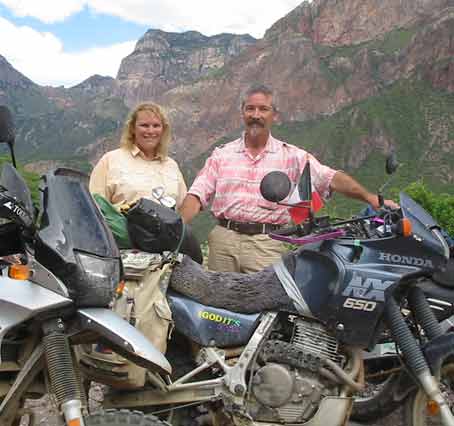
My
friends Judith and Jip Whitefield
Mes amis Judith and Jip Whitefield
Tarahumara indiens.
Les indiens Tarahumara.
View from the Copper Canyon.
Vue du Copper Canyon.
A friendly Mexican family.
Une aimable famille Mexicaine.
Tarahumara girls in their
traditional clothes.
Des femmes Tarahumara dans leurs habits habituelles.
View of Acapulco.
Vue d'Acapulco.
No comment.
Sans commentaire.
Tequila, tortillas, cactus...and
Mexicans!
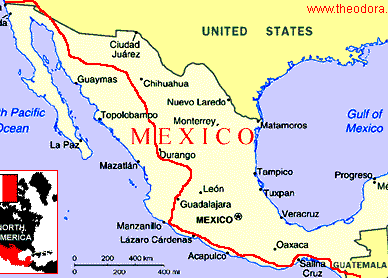
US$24 for the bike (for import permit). The whole process took over an hour,
the staff were friendly and the only problem was the heat as I had to carry
all my stuff around with me (that is the problem when traveling on your own;
there is no one to look after your gear).
By 3.30pm I was back on the road and determined to make it to Sonoita,
my target for the day. This region is inhabited and there is no petrol for 240km,
something that I did not know, I would surely have run out of petrol in the
middle of nowhere if I had not found a house who could sell me 5 litres of gasolina
at double the price. I eventually arrived in Sonoita at sunset, happy to be
in Mexico.
Covering almost 2 million sq. km, Mexico is big: it's nearly 4600km from
the US border to Guatemala by road. It has a population of around 100 million
today. In 1940 the population was counted at 20 million, in 1960 at 35 million
and in 1980 at 67 million. By official figures, the population is growing by
about 1.4% a year, which is down from rates of more than 3% between 1950 and
1980 but still means an extra 1.3 million mouths to feed every year. There is
20 million of Mexicans living legally or illegally in the United States. The
major ethnic division is between mestizos and indigenous people. Mestizos are
people of mixed ancestry - usually Spanish and indigenous. Indigenous people
are descendants of Mexico's pre-Hispanic inhabitants who have retained their
sense of distinct identity.
Mexico, the capital, has 20 million inhabitants and is much polluted.
I, then, traveled southwest to Hermosillo, going across the Sonoran Desert.
The road was excellent but the temperature still blistering hot. I spent the
night in Hermosillo and left early the next morning heading west to Barranca
del Cobre (Copper Canyon). The first 100km was on a good and straight road
with no traffic at all, and then it started to climb up the mountain. The scenery
was breathtaking and for the next 400km the road went up and down through green
valleys and small villages. With all those curves and corners I was averaging
no more than 50km/h but loving it. From the small town of Basaseachi I took
a short cut to Creel. It was a dirt road of 100km with no real difficulties
compared to some of the roads that I had ridden in Africa. I arrived in Creel
late in the afternoon and found a small pension run by a friendly family. Creel
is a pleasant small town surrounded by pine forests and interesting rock formations
at the edge of Copper Canyon. At 2300m above sea level, Creel is much cooler
and the piney aroma from the town's lumber mill was a welcome relief from the
heat of the lowlands.
Copper Canyon or Barranca del Cobre is a natural wonder that actually
refers to not one but 20 canyons carved out of the Sierra Tarahumara by over
six different rivers. Together, these canyons are four times larger than its
American counterpart (the Grand Canyon).
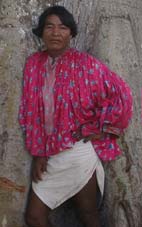
One
of Mexico's most numerous indigenous peoples, the Tarahumara (pictured),
still retain a traditional lifestyle here. More than 50,000 of them live in
the Sierra and they are famous for running long distances. Traditionally, they
hunted by chasing down and exhausting deer, then driving tem over cliffs to
be impaled on wooden sticks. Today, they run gruelling footraces of 160km, without
stopping, through rough canyons, kicking a small wooden ball ahead of them.
One night I met an American couple from the state of Washington traveling as
well on motorcycles. Judith and Jip Whitefield (both chief engineers
on ferry boats) had drove to the Mexican border in their car with the bikes
on a trailer and then, rode through northern Mexico for 3 weeks vacation. I
decided to join
them
for a ride to Batopilas, a serene 19th-century silver mining village
140km south of Creel and deep in the canyon country.
We left the next day at 10am; I had left most of my gear at the pension as I
knew that there was some hard riding to do. The first 70km was on a perfect
sealed road but the next 70km was off road. The journey turned up to be a thrilling
ride from an altitude of 2338m at Creel to 495m at Batopilas, with dramatic
descents and ascents through several canyons, climates and vegetative zones.
It took us around 6 hours for the trip, stopping many times to take pictures
and to admire the splendid sceneries but the rough riding took its toll on Judith
as she arrived completely exhausted. The climate was distinctly warmer and more
tropical than Creel's and we were now surrounded by stands of mangoes, bananas
and other tropical fruit trees instead of the cool pine forests of Creel. We
spent the next day recovering and exploring the surrounding sights.
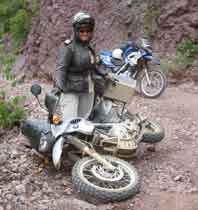
Riding back turned up to be even tougher for
Judith as the rain had made the dirt road very slippery but she managed very
well falling over just a couple of times (pictured).
The following day was a wet one so I decided to stay home but my American's
friends (tougher than me, no doubts) left for their return trip home.
Tuesday, 23 September.
Even though the sky was carrying a lot of very dark clouds and the rain had
just stopped, I decided that it was time to go. As I was saying goodbye to
a French
Tuesday,
16 September 2003.
I crossed the border at Mexicaly, some 150km West of San Diego, at 2pm. I was
told that the temperature was above the 40 degrees mark, I could feel it especialy
whenI had to go from one office to the other, getting photo copies and passport
stamp. I first had to pay US$23 for a tourist card then
family
that I had met a couple of days earlier, I told them that I did not sleep very
well and that my stomach was blotted, they admitted to me that they had a terrible
night as well and we decided to blame our last dinner which consisted of mainly
beans (not the green ones unfortunately). Obviously, gas had to be the problem,
likely I was not sharing my room with anyone.
The road was still wet but it did not rain at all for the rest of the day. I
covered only 365 Km that day as the road was very curvy but very scenic nonetheless.
The next day I woke up with a sore throat and runny nose but I wanted to reach
Zacatecas that day and I knew that it was over 700 Km away. Luck was
on my side though as the sun was out and the road more or less straight but
still beautiful. I left early and arrived at around 5pm without any problem.
I found a hotel suitable for my budget but had to find a park for my bike as
there was nowhere to keep it at the hotel. I located a public parking in the
centre and work out a deal with the owner, he promised me that it would be safe
and charged me a buck per night.
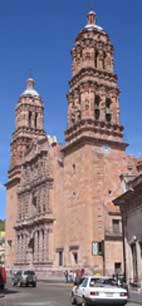
Set
amid dry, arid country, Zacatecas is a particularly beautiful and fascinating
city of over 100,000 habitants. It's a city with very fine colonial buildings,
including its most stunning cathedral (pictured), all built from the
riches of the local silver mines. It is cluster along narrow, winding streets
at the foot of a spectacular rock-topped hill. I had a great time exploring
this city and would highly recommend it to anyone visiting Mexico.
Two days later it was time to go but as I woke up that morning, the rain was
tumbling hard outside and I was still suffering from my cold so I just turned
over and went back to sleep (the pleasure of travelling alone, you don't have
to do anything if you don't want to). By 9am the rain had stopped but it was
too late for me to get going so I just lazed around all day.
The next day, same story, but this time I had to go and again it eventually
cleared in mid morning. I was heading toward the Pacific Coast as I wanted to
avoid Mexico City at all cost (I have been in that city before and had
no desire to see it again). I
reached
Guadalajara, the second largest city in Mexico, at around midday but
kept going as I wanted to spend the night at the small black-sand beach resort
town of Cuyutlán. After stopping for a quick lunch in a small local restaurant
I noticed some very alarming black clouds on the horizon. Earlier that day I
had witnessed the same thing and went through it without getting wet at all.
Thinking that the phenomenon would repeat itself I did not bother to stop and
put on my wet gear. Was it a mistake? Well, maybe not because what followed
turned up to be the worst storm I have ever gone through on a motorbike and
no wet gear could have kept me dry. After 5 minutes I was completely soaking
and cold and with 120 Km to go I was not about to stop as I knew that I would
never be able to get back on the bike. So I kept going, very slowly as I could
not see anything and the mountain road was very twisty. It was so bad that there
was no other car on the road and I could not see any change in the condition.
Then the thunder started and even though the rain was making a lot of noise
on my helmet, the blast of the thunder was so loud and so near that it would
make my jump out of my skin. I knew that my tyres would keep me safe from the
lightning. After a couple of hours of that tough going, averaging 20km/h, I
started to notice a slight relief; it was still pouring but not as hard and
then the road started to descent and the temperature to claim up. When I arrived
in Colima, 60 Km from my final destination for the day, the rain finally stopped
and the sun came out. It actually felt like going into a sauna, I was steaming,
the road was steaming and the countryside around me was steaming. It did not
take me long to warm up but with all the humidity in the air it was going to
take a bit longer for all my gear to dry. I arrived in Cuyutlán
at around 4pm and stopped at the first hotel that I saw as it was advertising
rooms for only 50 pesos per person ($US5.00), the lowest I had witness in Mexico
so far and at that price I did not even bother to check it out. At that rock
bottom price I knew that all I would get would be a bed in an empty room and
nothing else. I was not disappointed, at least it was clean and I even paid
for two nights thinking that it would at less take a full day for my gear to
dry out completely. Later on I started to explore what I thought would be quite
a nice peaceful place to relax. As it turned up there was no one around at all,
I don't mind some isolated beaches but this one was just a little too much remote
for my liking. In the heart of the town a few streets vendors were getting ready
to serve their tortillas and their tacos. On top of all that,
the place was full of mosquitoes. So after a quick dinner of "especialidades
mexicanas" it was time for bed and the promise of leaving early the next
morning from this not so welcoming place.
Of course, the following morning, when I asked for my money back for the extra
day that I had paid for, I was told that it had been registered and that it
was impossible to get it back. What I though was a bargain turned out to be
not so much a bargain after all. Never mind, Acapulco (690 Km away) was my next
stop and there was nothing that was going to prevent
me from getting there that day. The road followed the coast and I was treated
to some amazing views along the way. Palm trees, coconut trees and of course
banana trees were watching me as I was surfing the road with the Pacific Ocean
keeping an eye on me. The sky was perfectly blue and there was no sign of rain
at all. A perfect day at the office you might say.
I don't know about you but when I think of Acapulco I think of that American
series "The love boat" so when I arrived late that afternoon, the
first think I expected to see was the

famous boat and guess what? It was there! (Pictured).
Acapulco is also the granddaddy of Mexican coastal resort cities and
is set on a narrow coastal plain along the 11 Km shore of the Bahia de Acapulco.
Of course tourism is the city's number one industry and has been for decades
but that is not why I went there, I just
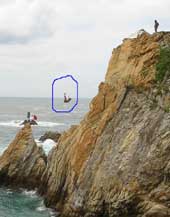
wanted to see the famous divers diving with graceful
finesse from heights of 25 to 45m into the ocean swells below (pictured). Of
course I would have joined them on top of that rock and jump with them but I
had to take the picture, didn't I?
Actually, Acapulco is a fast growing city of dual personalities. On one side
you have the curve of the Bahia where stretches an arc of beautiful beaches,
luxury hotels, discos, shopping plazas and restaurants and on the other side
you have the none-too-glamorous commercial centre with filthy streets, crowded
sidewalks, congested traffic, long lines of loud, fuming buses and of course
the hotel where I was staying. When I strolled in the "rich" district
I was quite envious of the people sitting in those
beautiful restaurants with white table cloths
and shining cutleries not to mention the delicious food as I knew that tonight
for my dinner I will be back with the streets vendors to eat some tortillas,
frijoles or a comida corrida for just a couple of dollars. I am not saying that
to make you feel sorry for me, I just wanted to point out that when you travel
for such a long time you have to budget all the time and not only when you are
on the road but also the years before you go as you have to save so much money
but as I said, it is my choice and I would not want it any other ways.
Tuesday, 30 September.
That morning, when I woke up, I was pleasantly surprise to see that my cold
had disappeared just as suddenly that it had appeared. I left early, planning
to make it to a small beach town called Zapolite some 500 Km farther south.
Again the sun was out and the heat was rising. It would have been a smooth ride
if it was not for the hundreds of topes (speed bumps) that I had to negotiate.
For some reason someone thought that it would be a great idea to put as many
of them as possible along the way. There did not seem to be as many inland but
they are definitely in force along the coastal road. I am sure that they are
good for something but I cannot see the reason to have so many and it is not
as if they were smooth ones either, no, they are the radicals ones that you
have to stop in order to get over them. In every little town there would be
at least six of them, sometime more. Usually they are signs to indicate them
or sometime they are painted in yellow so you can see them coming but it is
not always the case and when you don't see them coming and you go over them
at a normal speed you just about check all your luggage off the bike, not a
nice feeling, not to mention the damaged that you inflict to your vehicle. They
were driving me crazy.
Toward the middle of the afternoon I got through the 50,000 Km mark, quite an
achievement I thought and I even considered stopping to give the "birthday
girl" a kiss. It might sound a little strange to you but I have come to
depend so much on her (my god! I even call it "her") that it would
make sense. I have even become superstitious about the all thing, if someone
asks me "how is the bike going?" I would always answer "very
well" just in case that she hears me. Actually the day did not start that
well for the birthday girl. That morning, I had to roll the bike down three
steps to get out of the hotel, something that I have done before without any
problem but that morning I must have been over confident as I did not even start
the engine and lost my balance half way and crashed the bike mid way on the
stairs. Fortunately nothing got damaged except for the front indicator and the
gear lever.
I arrived in Zapolite early in the evening. Zapolite is fabled as southern
Mexico's ultimate place to lie back in a hammock and do as little as you like,
in as little as you like, for as little as you like. It stretches over 2 Km
of pale sand and is very popular with some leftover hippies. I stayed there
for a couple of days, meeting other travellers and relaxing.
Friday, 3 October.
With only 350 topes, 10 tortillas and 700 Km from the border of Guatemala
I was confident that I would reach it that evening. I had decided to bypass
popular places like Oaxaca and San Christóbal De Las Casas
for two reasons. The first one because I had heard that it was raining there
every day and the second one because I had already visited those places twice
before. Again the scenery was superb and I arrived in Talisman (the border
town) just before the rain. As I rode slowly to try to find a place for the
night I was surrounded by lots of kids running after me, offering to help me
to cross the border (for a small tip), to change money or to take me to a hotel
of their choice. I finally found a place to stay, just meters from the actual
border.
Well, crossing a border is hard enough at the best of time but now I will have
all those kids on my back tomorrow morning, I cannot wait.
Nos vemos en Guatemala.
For more photos click here.
Tonton Christobal est revenu!
Mardi 16 Septembre 2003.
J'ai passé la frontière à Mexicali, 150km à l'ouest
de San Diégo, par une chaleur ardente. Il faisait environ 40 degrés
quand, à 2 heures de l'après-midi, je me présentais à
l'immigration Mexicaine. J'ai du d'abord payer 23 Euros pour une carte de touriste
(valable 3 mois) puis 24 Euros pour un permis d'importation de la moto. Toutes
ces procédures ont pris environ une heure et demie mais la
difficulté était plutôt due
à la chaleur car je devais aller d'une place à l'autre en portant
toutes mes affaires (casque, blouson, sac etc.…). C'est dans ces moments
là que l'on apprécierait un compagnon pour surveiller la moto
et les bagages.
Je reprenais la route vers trois heures et demie en me promettant de gagner
Sonoita, mon objectif de la journée. Cette région est très
désertique et inhabitée mais je pensais quand même y trouver
de l'essence. Erreur, car je n'ai vu aucune pompe à essence le long des
240km et j'aurai certainement tombé en panne mais avec juste un litre
dans le réservoir et 120km à faire j'ai trouvé une maison
sur le bord de la route où les habitants m'ont vendu 5 litres de ce précieux
liquide, bien sur à un prix double. Je suis éventuellement arrivé
à Sonoita à la nuit tombante, crevé par la chaleur mais
content d'être au Mexique.
Il en a pas l'air comme ça mais le Mexique est un grand pays (Cliquez
ici pour voir la carte) qui fait presque 4 fois la France: il y a environ
4600 Km de la frontière des Etats-Unis jusqu'au Guatemala par la route
ou 3500 Km à vol d'oiseau. Au nord, la frontière avec les Etats-Unis
s'étale sur 3200 Km. On comprend pourquoi, malgré une surveillance
de plus en plus sophistiquée des Américains, nombreux sont encore
les Mexicains qui arrivent à passer clandestinement la frontière.
Plus de 20 millions de Mexicains, légaux ou illégaux, travaillent
aux Etats-Unis. Aujourd'hui le Mexique compte 100 millions d'habitants. En 1940
il y en avait 20 millions, en 1960 35 millions et en 1980 67millions. D'après
les statistiques officielles, la population augmente de 1,4% par an, certes
moins que dans les années 50 où elle augmentait de 3% mais toujours
très hautes car cela donne 1,3 millions de bouches de plus à nourrir
par an. C'est une population jeune dont la moitié à moins de 22ans.
Mexico, la capitale, sans aucun doute la plus grande agglomération du
monde avec Tokyo et Sâo Paulo, compte 20 millions d'habitants. C'est aussi
une ville très polluée.
Le lendemain, je repartais vers le sud-ouest direction Hermosillo, en
passant par le désert de Sonoran. La route était excellente mais
la température toujours aussi intolérable. J'ai passé la
nuit à Hermosillo et je suis reparti tôt le lendemain matin vers
l'est en direction de Barranca del Cobre (le canyon du cuivre). La route
était bien droite pour les premiers 100 Km, sans aucune circulation,
puis petit à petit elle a commencé à monter dans la montagne.
Les vues étaient magnifiques et pendant 400 Km la route serpenta la montagne,
passant à travers des vallées bien vertes et des petits villages
pittoresques. Avec tous ces virages j'arrivais à peine à faire
50 Km/h de moyenne mais je m'amusais comme un fou. Au petit village de Basaseachi
j'ai pris un raccourci pour Créel. C'était une route non goudronnée
de 100 Km sans difficultés comparées à l'Afrique.
Je suis arrivé à Créel tard dans l'après-midi et
j'ai trouvé une petite pension tenue par une famille locale très
aimable. Créel est une charmante petite ville entourée
de forêts de pins et de formations rocheuses intéressantes à
l'orée du Canyon de cuivre. A 2300 mètres au-dessus du niveau
de la mer, Créel bénéficie d'un climat beaucoup plus frais
que dans les plaines.
Cette région de gorges abruptes, quatre fois plus importante que le Grand
Canyon du Colorado, est pleine de rivières impétueuses nées
dans les hautes forêts de pins. Une multiplicité de microclimats
et d'écosystèmes, dont profitent les Indiens Tarahumaras
(photo ci-contre)qui ont trouvé refuge ici.
 |
 |
 |
 |
 |
 |
 |
 |
 |
 |
 |
 |
 |
|
JOURNAL 25.
03/10/03 . Mexico . Total mileage
so far 50,810km .
(Pour la version française
du journal, allez au bas de la page ou cliquez
içi.
Pour revenir à la version française du site, cliquez
sur Français)
How
can you help make Ride4Kids a worthwhile project? To find out,
click here.
|
|






